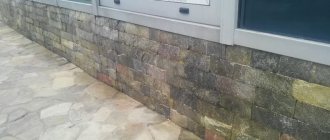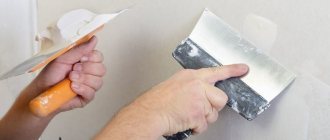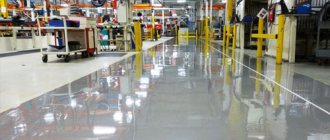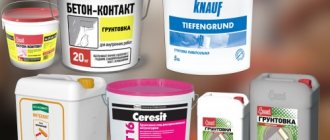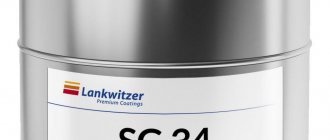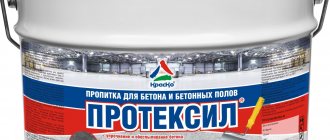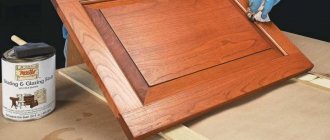Concrete is a strong, durable material. However, it must be protected from moisture, UV rays, and chemicals, which can cause rapid deterioration of the base. To improve the quality of the material, concrete impregnation is necessary. When choosing, you should focus not only on the cost of the compositions, but also on their properties, manufacturer, and purpose of use.
Why strengthen concrete?
The vast majority of industrial floors are made on the basis of concrete and cement-sand mortars. With all the abundance of advantages of such materials, constant exposure to air, aggressive chemicals, water, mechanical and temperature loads slowly but surely provoke the destruction of the front layer.
In addition, concrete is susceptible to carbon dioxide corrosion, which leads to dust. During operation, the strength of the screed decreases and we see potholes, chips, and cracks on the surface .
Elimination of salts on the concrete mass ensures the absence of dust
To eliminate all negative factors and obtain dust-free, durable and strong foundations, hardening impregnations for concrete are used. Modern technologies make it possible to stabilize the surface. As a result, the possibility of the formation of cracks and defects is minimized, and the salts present in the concrete matrix are bound. Elimination of salts ensures the absence of dust.
I can say that hardening impregnations demonstrate high penetrating ability. They successfully bind concrete, provide rapid polymerization, high wear resistance, low abrasion and protect the surface. If we talk about industrial floors and other critical structures, they require mandatory high-quality treatment with such compounds.
How and why water-repellent additives are introduced into concrete
Hydrophobic additives increase the moisture-repellent properties of the concrete mass. They are introduced into the concrete composition using various methods:
Hydrophobizing additives for concrete GKZh and other brands of modifiers are designed to solve the following problems:
- increasing the moisture resistance of the concrete mass;
- increasing strength characteristics;
- improving thermal insulation properties.
Changing the performance properties of concrete is achieved through strengthening and waterproofing with impregnating compounds.
What is hardening impregnation for concrete?
Concrete hardeners are chemically active compounds on an organic or inorganic basis. They ensure tightness and effectively prevent dust formation . Concrete processed using the technology does not collapse under loads. Plus, this type of impact perfectly and quickly restores worn-out and old concrete foundations.
Reinforcers are recommended for use in warehouses, retail premises, production shops, garages, car service centers, hangars, wood processing enterprises, mechanical engineering, machine tool manufacturing, chemical industries, medical institutions, and printing houses.
Treating floors with impregnations is a prerequisite for production in the pharmaceutical and food industries , where it is necessary to prevent contact of cement dust with the manufactured product.
Treated concrete acquires the following properties:
- hardening;
- multiple increase in wear resistance;
- ensuring moisture resistance, water resistance;
- complete dust removal and protection from subsequent dust formation;
- increasing service life;
- reducing the cost of installing finishing coatings.
In addition to resistance to mechanical loads, wear resistance, impact resistance, and dust removal, we can talk about a significant acceleration in the time it takes to put a facility into active operation. This is an important factor in modern construction conditions. Concrete with a hardener is produced in one working pass . Impregnations provide high productivity - from 500 sq.m. per day. The bases are ready within 72 hours.
Types of impregnations, their purpose and application
Impregnation is a mixture of special components, depending on the composition, sealing the surface or changing its structure. Unlike traditionally used primers, this product penetrates deeper into the material. As a result, a fairly thick hardened layer is formed, giving the surface increased resistance to the following series of destructive factors:
- Abrasion.
- Pressure.
- Mechanical loads.
- Freezing.
- Overheat.
- Temperature changes.
- Getting wet.
- Formation of microcracks.
- Corrosion (for reinforced concrete products).
After treatment, the surface layer stops producing dust and acquires water-repellent properties.
Types of impregnations according to the principle of action
Based on the principle of action on the concrete surface, deep penetration impregnations are divided into 2 types:
- Strengthening.
- Waterproofing.
Drops of water are not absorbed into the hydrophobic surface of concrete Source mpkm.org
The former make the surface layer more durable, the latter make it water-repellent. Based on the composition of their components, they are divided into 2 categories:
- Organic. They are made on the basis of polyurethane, acrylic and epoxy resin. The mechanism of action is to fill surface micropores and thereby improve the strength, water-repellent properties of concrete and resistance to aggressive environments.
- Inorganic. The product contains substances that react with the concrete mass. The components formed as a result of this interaction firmly settle on the surface and protect it from harmful factors.
Advice! Some types of impregnations change color when exposed to sunlight. For example, epoxy mixtures are best used indoors, since under the influence of ultraviolet radiation they give the concrete a yellowish tint.
Application
Impregnation of surface pores in concrete at a deep level is necessary in the following cases:
- Increased mechanical load – floors in public places, warehouses, workshops, parking lots. The reinforced layer must have sufficient thickness, otherwise it will quickly collapse.
Reinforced concrete screed Source effgroup.ru
- Dense types of concrete. The higher the density of the material, the smaller the pores. Therefore, it is necessary to use impregnation to strengthen concrete with a high penetration rate.
- Thick screed - to give more strength to the entire structure.
Note! Polyurethane-based products have the maximum impregnation ability. They bind cement dust and material, forming a single polymer layer characterized by significant resistance to impact, abrasion, wetting and aggressive substances.
Classification
Inorganic substances are able to penetrate into the structure of the surface layer . As a rule, they are based on sodium and potassium compounds and are deeply embedded in the concrete body.
Materials capable of strengthening concrete are divided into organic and inorganic, depending on their composition. It is the latter type that is considered the best strengthening impregnations
Epoxy varieties are used much less frequently, since silicates provide better final concrete characteristics. For the same reason, polyurethane impregnations are not used so often. However, for an overview of all types of hardeners, it makes sense to consider them too.
Main types of strengthening impregnations:
- silicone (silicon, organosilicon) - based on sodium, magnesium, potassium fluorosilicates, colloidal polysilicates);
- lithium - based on lithium silicates. Essentially, this is a type of silicon impregnation, but in our market they are positioned as a separate group;
- epoxy – based on epoxy resins;
- polyurethane – in this case we mean the use of polyurethane varnishes (water-based).
Lithium concrete hardeners with anti-contamination properties
Lithium impregnations are a modern product specially designed for harsh operating conditions. They can be used two days after laying concrete, which is not available to some very popular analogues.
The main purpose of lithium strengthener is compaction, strengthening, hydrophobization
The material helps improve the characteristics of the finishing layer, reduces water absorption, and provides protection against dirt.
Specifications
| Name | Technical specifications |
| Appearance | Colorless, opalescent liquid |
| Active component content, % | 7 |
| Content of organic volatile substances, % | 0 |
| Density g/cm3 | 1.06 |
| pH | 10.5 |
| Dry residue, % | 7 |
| Boiling point, C | 100 |
| Solubility in water | Completely soluble |
| Viscosity | 10 mPa*s |
| Freezing temperature, C | 0 |
Advantages:
- lithium impregnations are of the latest generation; they do not give an alkali-silicate reaction. The base eliminates the risk of forming a network of small cracks;
- increase in concrete wear resistance by 20-50%;
- increase in compressive strength by 10-30%;
- increase in peel strength by 25-75%;
- dust removal;
- strengthening and protection of old and new concrete;
- lithium impregnation works when constructing street areas, paths, etc.;
- an appropriate alternative to toppings;
- bio-, fire protection;
- moisture resistance.
Flaws:
- Perhaps the only negative is the high price. This is typical even for products from domestic manufacturers.
Silicate impregnations for outdoor concrete
In this case we are talking about water-based silicate polymers. Such materials are non-flammable, non-toxic, odorless and explosion-proof. Silicate hardeners are economical and work both indoors and outdoors. The composition can be applied to freshly laid and dry concrete . One impregnation is sufficient for the entire service life. No film susceptible to abrasion is formed on the surface of the base. Concrete stops dusting and acquires a soft velvety shine.
Scope of application: open areas, warehouses, production workshops, parking lots, garages, shopping centers, markets, areas with high traffic and pedestrian load.
The average consumption of silicate impregnation is 0.14-0.35 l/sq.m. The final consumption depends on the roughness and porosity of the concrete
Specifications
| Name | Technical specifications |
| Appearance | Liquid without color |
| Active component content, % | 6 |
| Content of organic volatile substances, % | 0 |
| Density g/cm3 | 1.05 |
| pH | 11 |
| Dry residue, % | 6 |
| Flash point | Nonflammable |
| Freezing temperature, C | 0 |
Advantages:
- easy application in one step;
- no efflorescence;
- unlike lithium analogues, no flushing is required;
- high strength;
- Possibility of use on concrete with previously applied hardeners, rubbed, untreated bases.
Flaws:
- In general terms, such impregnations cause an alkali-silicate reaction. If there is silica in the concrete filler, it will lead to internal stresses. This causes cracking. A network of small cracks or large cracks (“card” cracks) may appear on the base. The defect can appear either after a couple of days or after several years;
- When working on concrete, the material absorbs moisture rather than repels it;
- the reaction with concrete may not occur completely, so that lime agglomerates may remain over the entire surface.
Reinforcers based on PVC resins
Such materials demonstrate versatility and ease of application. Concrete and concrete floors receive wear resistance and minimal abrasion, dust removal and hardening. The compositions work on old and new substrates, including low-grade concrete.
Organic-based liquid hardeners are designed to protect against increased transport and mechanical loads, and from aggressive environments . The peculiarity is that the composition can be applied at subzero temperatures.
Scope of application:
- strengthening of bases before applying polymer coatings;
- protection of floors from high shock and mechanical loads;
- hardeners are effective in car service centers, parking lots, parking lots, open areas, warehouses, markets, wholesale warehouses, terminals, utility rooms and production workshops, in the food industry (refrigeration plants, breweries, meat processing plants).
The penetration depth of PVC resins is up to 5 mm and above. Consumption – 0.2-0.35 l/sq.m.
Specifications
| Name | Technical specifications |
| Impregnation basis | PVC resin |
| Mass. share of non-volatile substances, % | 8-13 |
| Viscosity, s | 12 |
| Drying time up to 3 tbsp., h | 1 |
Advantages:
- high adhesion;
- a hardened surface with high hardness is formed;
- quick restoration of old and worn foundations;
- resuscitation of surfaces that at first glance require complete dismantling;
- the composition penetrates inside the artificial stone, causing a chemical reaction. High-strength crystalline compounds are formed in the concrete matrix, which causes effective strengthening;
- versatility - you can work in any type of premises, be it in winter or in summer.
Flaws:
- tendency to become dirty;
- low resistance to negative temperatures.
Water-based acrylic hardeners
Water-based polymer acrylic impregnations are capable of penetrating deeply into the capillary-porous structure of concrete.
The composition interacts with the components of the artificial stone and forms insoluble thread-like crystals - they fill the microcracks, pores and capillaries of concrete.
As a result, the base is strengthened and dusting and surface destruction are prevented. Strengtheners work on concrete not lower than M200. They are not effective on lower grades.
Scope of application:
Acrylic impregnations are used to strengthen industrial concrete floors and for the installation of household concrete screeds. The material is effective for preparing bases for laying finishing coatings, including polymer ones, in office premises. Strengtheners are characterized by hydrophobic properties and can work in conditions with high humidity and where high hygiene is required.
Used where department stores, consumer service facilities, supermarkets, production workshops, wholesale depots, warehouses, wet shops, pharmaceutical, food industry, parking lots, terminals, parking lots, car services.
Penetration depth – up to 1 mm or more. Consumption – 0.2-0.35 kg/sq.m.
Specifications
| Name | Technical specifications |
| Mass. share of non-volatile substances, % | 22.0-27.00 |
| Viscosity, s | 15 |
| Drying up to 3 tbsp., hours | 1 |
Objects of application: outside and inside public and industrial facilities
Advantages:
- strengthening of concrete by 1.5-2 times;
- the composition is effective on old and new substrates;
- without smell;
- high penetrating ability;
- dust removal;
- hydrophobic layer;
- environmental friendliness;
- versatility, ease of application.
Flaws:
- storage and transportation are possible at temperatures not lower than zero degrees, which limits the possibilities of application;
- the effectiveness of impregnations lasts 2-3 years, after which an update is required;
- scanty penetration depth - about 1 mm.
Epoxy based reinforcers
Epoxy impregnations are two-component aqueous compositions based on epoxy resins.
The material works on fresh or old concrete, including application on damp substrates..
If the hardener is introduced into fresh concrete, it contributes to better corrosion resistance, frost resistance and better aging. It is this solution that works well in combination with epoxy self-leveling floors.
This solution can be called optimal for food industry workshops, freezers, refrigerators, and medical facilities.
Specifications
| Name | Technical specifications |
| The basis | Epoxy resins |
| Impregnation depth | 1-2 mm |
| Mass. proportion of non-volatile substances (component A/B) | 98/45 % |
| Viability | 4 hours |
Advantages:
- strengthening of concrete 2-3 times;
- increasing hardness, preventing crack formation;
- protection from the aggressive effects of fuels and lubricants, water, solutions of salts, alkalis, acids;
Flaws:
- hardeners are inferior to analogues in terms of resistance to chemical and mechanical stress;
- low UV resistance limits outdoor use;
- small penetration depth - 1-2 mm.
Epoxy impregnation ensures concrete resistance to chemicals, removes dust, gives high strength, impermeability to moisture and other compounds
Polyurethane concrete hardeners
Polyurethane hardeners can be of two types - simple and deep penetration. In the first case, the composition penetrates into the concrete to a depth of 2-3 mm, in the second - 4-5 mm or more. It is worth noting that deep penetration impregnations are two-component and can work on concrete with high humidity and weak concrete of the M150 brand , which distinguishes this type. But here you should prepare for higher consumption.
Both materials are intended for treating substrates indoors, outdoors, and under a canopy. Impregnations are used in warehouses, terminals, garages, production shops, retail, exhibition halls, refrigerators, freezers. Plus, polyurethane is in demand in the food industry, healthcare, and nuclear energy.
Specifications
| Name | Technical specifications |
| The basis | Polyurethane polymers |
| Mass. proportion of non-volatile substances | 50% |
| Viscosity | 15 s |
| Penetration ability | 2-6 mm |
| Film strength upon impact/bending | 50 cm/1 mm |
| Hazard Class | No |
| Gloss level | Glossy |
| Coating hardness | 0.4 |
Advantages:
- multiple increase in the grade strength of concrete;
- increase in wear resistance by 8-10 times;
- the impact resistance of concrete is doubled;
- waterproof, airtight, resistant to aggressive substances;
- complete dust removal;
- quick application.
Flaws:
- if the base will be operated at sub-zero temperatures, an additional anti-slip impregnation is applied;
- the material works only on mature concrete;
- when used outdoors, a waterproofing layer is required;
- One-component formulations are not effective on wet substrates.
Fluat-impregnation for concrete strengthening
Fluidating impregnations for concrete are very economical. This is a non-flammable material suitable for indoor and outdoor use. We can confidently say that there is an increase in strength, dust removal, and an increase in the chemical stability of bases. Fluat successfully resists the formation of cracks .
Such compositions are used for economical impregnation of concrete bases of warehouses, storage facilities, garages, production workshops, on open concrete sites, runways, and airfields. It is worth noting that the impregnation works on new and old substrates, penetrating into the thickness to a depth of 5 mm or more.
Fluates do not have a corrosive effect on fittings
Advantages:
- increase in strength by 30-50%;
- improvement in wear resistance by 10-12 times;
- non-flammable;
- protection from moisture, chemicals, oils;
- does not wash out from concrete, applied once;
- vapor permeability;
- increased frost resistance;
- operating temperature -60+80 degrees.
Flaws:
- low efficiency on low-quality, very old concrete, on freshly laid concrete up to 10 days old.
Functional properties of impregnations
To decide how to treat concrete, you need to know what you want to achieve from such treatment. Based on the properties of the impregnation, it is conventionally divided into:
- strengthening;
- water-repellent;
- dust removal;
- coloring.
Strengthening impregnations
Liquids for deep concrete strengthening are often inorganic in composition, based on silicates. Previously, these were potassium and sodium silicates.
Knowing this, you can make the impregnation yourself at your own risk. To do this, take silicate glue and dilute it with water in a ratio of 1:5. (Also sometimes, if the surface is completely destroyed, you can try a liquid solution of lime or cement.)
Now potassium and sodium compounds have been replaced by lithium impregnation for deep penetration concrete. Here's how it's better:
- does not lead to efflorescence;
- concrete does not wear out and does not generate dust;
- strength increases 2-3 times.
They have one thing in common: inorganic compounds not only create a protective layer, but enter into a chemical reaction with the substances contained in cement. In this case, new substances are formed - insoluble in water, and the concrete becomes hard, impermeable to moisture.
There are also polymer hardeners with a penetrating effect, which change the very crystal lattice of concrete from the inside, but more often organic impregnations simply protect the surface from the outside.
Water-repellent impregnations
The service life of a concrete coating depends not only on its strength. Water, as they say, wears away stone – or, in our case, concrete. Therefore, where humidity is high, it must be protected from water and dampness.
Hydrophobic primers prevent moisture from seeping into the concrete, and thanks to this:
- structures made from it become more resistant to frost;
- fungi do not multiply inside;
- no efflorescence occurs on the surface.
However, impregnations do not protect the foundation from groundwater! A waterproof layer must be laid underneath.
Dust-removing impregnations
In enclosed spaces, dust is controlled to make cleaning easier and to take care of people's health. But the appearance of dust is also a signal that the concrete surface cannot withstand mechanical loads. Therefore, such impregnations are widely used outdoors to protect areas from wear.
COOL impregnation for a CRAP screed!!!
Coloring compounds
If you paint concrete with regular paint, it will rub off. If the load on the surface is constant, then this will happen very soon. Therefore, a special color impregnation is needed. It differs in that it penetrates into the depth of concrete by 3 mm. This primer will not peel off.
To fix the color, treat the top of the painted surface with a hydrophobic impregnation.
Technology of applying epoxy impregnations
The material is applied to concrete of a grade not lower than M200. The humidity of the base should not exceed 4% by weight. Relative humidity is standardized no higher than 80%. Epoxy impregnations are applied to mature concrete (aging for at least 28 days); they work much less frequently on fresh substrates .
The air-to-base temperature should be 3 degrees above the dew point; base, air - +5-25 degrees; impregnation - +15-25 degrees.
Preparation
The top loose layer is removed from the base, for which grinding machines and hard brushes are used. The working mixture also requires preparation - both components are mixed and processed with a construction mixer. The result should be a homogeneous composition, which is left for several minutes to allow the entrained air to escape.
Application
Before applying the impregnation, the concrete is dedusted using an industrial vacuum cleaner. The composition is applied with rollers or brushes, working “crosswise”, controlling the formation of puddles. As a rule, 1-2 layers are implemented. It is necessary to observe layer-by-layer drying for 16-24 hours. Average consumption is 220-500 g/sq.m.
Why does concrete deteriorate and what exactly does it need to be protected from?
5.2 Degree of aggressive media
5.2.1 Depending on the physical state, aggressive media are divided into gaseous, liquid and solid. Depending on the intensity of the aggressive impact on concrete and reinforced concrete structures, environments are divided into non-aggressive, slightly aggressive, moderately aggressive and highly aggressive. Depending on the nature of the impact of aggressive media on concrete, media are divided into chemical (for example, sulfate, magnesium, acid, alkaline, etc.) and biologically active (for example, the chemical effect of metabolic products of fungi, bacteria, physical and mechanical effects of plant roots, fungal hyphae, fouling by algae, lichens, etc.).
5.2.2 Depending on the conditions of exposure to aggressive media on concrete, media are divided into classes, which are determined in relation to specific concrete and reinforced concrete unprotected from corrosion. Classes of media indicating their indices in increasing aggressiveness are shown in Table A.1.
5.2.3 When simultaneously exposed to aggressive environments with different indices, but of the same class, the requirements relating to the environment with a higher index are applied (unless otherwise specified in the project).
5.2.4 Classification of operating environments and the degree of aggressive influence of environments on structures made of concrete and reinforced concrete are given in Appendices A, B, C and D:
- gaseous media - tables A.1, B.1, B.2;
- solid media - tables A.1, B.3, B.4, C.1, C.2;
- soils above the groundwater level - tables A.1, B.1, B.2;
- liquid inorganic media - tables A.1, B.3, B.4, B.5, D.2;
- chlorides - tables A.1, B.3, B.4, C.2, C.3, D.2;
- liquid organic media - tables A.1, B.6;
- biologically active media - table B.7.
Technology of applying polyurethane impregnations
The material requires compliance with some recommendations. The humidity of the base by weight should not exceed 4%, relative air humidity – 80%. The concrete must be mature, cured for at least 28 days. The air and base temperature should correspond to -30+25 degrees, the air-base temperature should be 3 degrees above the dew point, the material temperature should be +10 degrees.
One-component polyurethane impregnations are ready for use, two-component ones are mixed in accordance with the manufacturer’s recommendations
Preparation
The base must be cleaned by grinding, sandblasting or shot blasting. In hard-to-reach areas, for example, along junctions, it is permissible to use a hand-held grinder. The resulting sludge is swept away with brushes, and the surface is additionally dusted with a construction vacuum cleaner.
If it is necessary to obtain a filler pattern, grinding is carried out in several stages : coarse grouting 3-5 mm, medium, fine, where fine grain is used. If the base requires repair, it is carried out after closing the pores before applying the finishing layer.
Application
Polyurethane impregnations are applied until the concrete is completely saturated. This can be easily observed by visual inspection - a uniform gloss should form on the surface. The formation of puddles is unacceptable. If unimpregnated areas are identified, they are covered again. If required, additional primer is applied.
Sealers and curings. Is there any hardening?
The hardening effect is quite acceptable, but it can only be associated with better conditions for the hydration of cement in concrete, compared to other methods of protecting it. The mechanical and abrasive strength of these materials is low, because they are not intended to be a long-term solution to this problem. Manufacturers and sellers of fresh concrete care products today fully agree with this last statement. Recognizing a sealer or curing is quite simple: in most cases, in the name they contain either the syllable “seal” or the syllable “kure” (“cure”). To be on the safe side, you can look for the chemical composition in the description. If the composition contains a mention of acrylic dispersion or acrylic varnish, this is most likely a concrete care product.
Fluate application technology
The material is applied to concrete that has been cured for at least 14 days. The temperature of the base and air is +5 degrees, the humidity of the base is not higher than 7% by weight. Air humidity is not standardized. For impregnation, chemical impregnation for concrete is used - fluate and water-based acrylic impregnation for sealing.
Preparation
The top loose layer, dirt, and oils are removed from the concrete. Use a grinder or brushes. The pores of the base must be open . The resulting dust is removed with construction vacuum cleaners. Fluate chemical impregnation is diluted with water (3 liters of water per 1 liter of concentrate) - average consumption 1 liter/sq.m. Acrylic - diluted 1 liter per 1 liter - average consumption - 0.3-0.4 l/sq.m. for 2 layers.
Tools and equipment used: brushes, rollers, grinders.
Application
First, treatment is carried out with diluted fluate. The finished composition is poured onto the concrete and evenly distributed with brushes. After 15-30 minutes, the composition should be redistributed. Material should not pool . Exposure – a day.
Next, the acrylic composition is applied with rollers, working in a criss-cross manner. If required, an additional layer is distributed. Layer-by-layer drying takes 1-1.5 hours. After 24 hours, you can walk on the base. Full load is permissible after 3 days.
Review from different manufacturers
When purchasing deep penetration impregnation for concrete, the manufacturer must also be taken into account. You should not save money by choosing formulations from unknown companies - such solutions may adhere worse and have worse characteristics. It is better to choose compounds from manufacturers that have high reliability ratings, even if they are more expensive.
Strengthening primer for concrete floors - protector
The main task of the Protector is to increase the strength of the treated surfaces and the resistance of the material to chemicals. The composition also removes dust from the substrate. Suitable for treating paths and floors in residential areas.
The Protector is sold in 20-liter containers costing from 3,500 rubles.
Strengthening - retroplate
This concrete impregnation is used for treating floors made of low-grade materials and for mosaic coverings. When working with Retroplate, keep the following points in mind:
- cannot be used immediately after pouring concrete - at least two weeks must pass;
- the temperature during work must be at least +5 °C.
Retroplate is produced in 20 liter buckets, the cost is about 8,000 rubles in Moscow stores.
Organic - protexil
Protexil is an impregnation developed for use in industrial facilities. It protects floors from exposure to chemicals and mechanical stress.
Impregnation characteristics:
- penetrates to a depth of 1 cm;
- material consumption per 1 liter - from 300 ml;
- ability to work at temperatures from -40 °C to +80 °C;
- Drying time at temperatures from +20 °C is 6-7 hours.
The cost of impregnation for 1 liter is from 180 rubles.
Universal - monolith 20 m
This impregnation is water-based, which makes it non-flammable and environmentally friendly.
Advantages of the universal solution Monolith:
- increase in water resistance of the concrete base by 3 grades;
- increased stability by 30%;
- reduced material warping, improved adhesion;
- increasing the resistance of the material to acids.
Consumption of the composition is about 1 liter per 5 square meters, which depends on the porosity of the base. The cost of 1 liter of impregnation is from 140 rubles.
Aquastone
Aquastone provides dust removal and protects the surface of floors. It is characterized by deep penetration, which gives strength to concrete surfaces. Can be used for application in both apartments and industrial facilities. Recommended for use on surfaces with high humidity levels. 1 liter of Aquastone is sold at a price of 230 rubles.
Aquasol
This impregnation is characterized by high water-repellent properties and can be used for application to any coating made from cement. Sold at a price of 210 rubles. for 1 liter of impregnation.
Epoxol
Used to cover concrete and cement floors. Epoxol, made on the basis of epoxy components, increases the strength of coatings by 3 times and prevents the appearance of cracks. One of the few compounds that can be used to treat wet coatings.
It can be used not only in apartments, but also in medical centers and children's educational institutions, since it is environmentally friendly and safe. Price for 1 liter - from 350 rubles.
Ashford formula
Made on a water basis. It is recommended to use it to increase the strength of coatings in apartments, open areas, markets, shopping centers, and parking lots. The cost of 1 liter of Ashford formula is from 100 rubles.
Technology for applying strengthening impregnations based on PVC resins
Work on applying impregnation is preceded by preliminary preparation. Surfaces must be cleaned of all dirt and remnants of old coatings. The material cannot be applied to cement laitance, as this will prevent penetration into the thickness of concrete. Sanding, sandblasting or shot blasting are used for cleaning and preparation.
Tools used : brushes, rollers
The average consumption of reinforcing impregnations based on PVC resins is 0.2-0.35 liters per sq.m.
Application
The impregnation is distributed over a dry, cleaned base. If uneven absorption is detected, it is recommended to apply another layer. Work is carried out at a temperature not lower than – 20 degrees. Drying time – 3-6 hours.
Protection of concrete from water penetration. Water repellents and liquid penetrating waterproofing.
Also, a large class of “impregnations” are water repellents and liquid penetrating waterproofing materials. The purpose of both is actually the same - to prevent moisture from seeping through the thickness of the concrete structure. The mechanism of action, however, is different. If water repellents are more similar to film-forming compounds and the mechanism of action fully corresponds to the name of this type: “hydro” - water, “phobos” - dislike, then penetrating compounds form a waterproof membrane in the thickness of concrete due to the calmatizing effect. In neither case is any hardening observed. The most noticeable effect is an increase in frost resistance. The reasons for this are easily explained - by not allowing water inside the concrete structure, the material automatically eliminates the fact of repeated freezing and thawing of water, which is accompanied by a change in volume due to different densities of water and ice.
It is the increase in volume that water occupies when freezing that leads to the gradual destruction of the structure. Accordingly, if there is no water in the structure, then there are no destructive deformations and, therefore, the frost resistance of concrete increases.
Technology for adding water-based acrylic hardeners
Concrete treatment can be carried out a day after pouring the concrete floor (in general, the exposure time depends on the manufacturer’s recommendations). The composition is applied at a temperature not lower than zero degrees. The work uses brushes, rollers, and paint sprayers. The hardener is applied in 1-2 layers. Do not allow the formation of a varnish film on the surface . Drying time – 3-6 hours, operating temperature – -40+80 degrees.
When the hardener is applied and dried, grinding is carried out. This is necessary to ensure high adhesion to the finish coating. Water is used to clean the instrument.
Important nuances
When constructing concrete paths on the street, additional treatment with a water repellent is mandatory. This work is carried out directly on the construction site. The main reasons for the destruction of concrete structures on the street can be exposure to precipitation, moisture or low temperatures.
Particular damage to the base can be caused by freezing of the solution in cement voids. To prevent possible damage, you need to impregnate the material with special substances that seal the surface.
As you can see from the article, processing concrete on the street is not a very labor-intensive job. The main thing is to choose the right solutions with hydrophobic properties. Experts recommend paying attention only to formulations with quality certificates. The processing process itself is simple; even a beginner in the construction craft can handle the work. You just need to follow the instructions on the packaging.
Review of popular products (2 videos)
Water-repellent impregnations and paints for concrete (26 photos)
Technology for applying lithium hardeners
To achieve maximum hardening, the maturity of concrete should be 28 days. If the material is laid on fresh concrete, then the work is carried out immediately after grouting and cutting the seams. The average consumption is 0.10-0.20 l/sq.m.
Equipment for preliminary preparation and application:
- Low pressure sprayers (pump type) - professional machines are used to ensure stable results. The use of an airless type is not necessary. After work, the equipment is washed with water;
- rotary scrubber dryers - in this case, a large wet-abrasive application is carried out. They operate with equipment with a rotation speed of 175 rpm. The attachments used are brushes with soft polymer bristles and pads;
- washing vacuum cleaners with a flat rubber nozzle - equipment is used to remove wet deposits after sanding and rinsing the base with water;
- Large brushes with nylon bristles are used to distribute the hardener after application ;
- grinding machines with diamond segments, polishing discs with a reduced degree of grit.
Preparation
Surfaces not involved in work are protected from dirt, splashes, and contact with equipment. The work area is overlapped and divided into separate zones. Seams, columns, walls and other structures are used as reference points.
Wet concrete is dried until the pores are free of water . At high humidity and low temperatures, drying is increased. Next, the concrete is polished to a degree of 80-200 grit. After grinding, the surface contaminated with fats, oils and other substances is thoroughly cleaned.
Preparation of material:
- if the concrete is hard, high-strength, bladed lithium hardener can be diluted with water in a 1:1 ratio;
- on medium-hard concrete they work with impregnation diluted to a degree of 1:0.5;
- on weak and porous bases they work with a composition of maximum concentration, that is, undiluted.
After applying the hardener, it is necessary to ensure that the composition remains in liquid form on the base for 30 minutes
Application of lithium hardener
Sequencing:
- the material can be applied by pouring, after which it is rubbed into the concrete with brushes;
- If the impregnation is applied to the surface by spraying, use a large brush with soft nylon bristles for thorough distribution. Use a tool to rub and distribute the composition;
- if a scrubber dryer is used, the material is applied to the surface by pouring and rubbed in with soft brushes or pads.
If dry zones form, additional impregnation is introduced, which is evident from the formation of a shiny wet film.
When 30 minutes have elapsed, use a construction vacuum cleaner or scrubber dryer to remove excess impregnation . Next, the surface is washed with water, which is collected with a vacuum cleaner. Next, the concrete must dry completely, which will take from 30 minutes to several hours. After impregnation, the treated surface is polished until the final roughness is achieved.
conclusions
Currently, lithium and silicate impregnations for concrete have shown maximum efficiency . They provide better performance characteristics of the finished coating (especially when paired with membrane formers) and can work indoors and outdoors in places for various purposes. However, application can only be carried out at positive temperatures and on durable concrete, which is not always appropriate.
High decorative properties are provided by colored liquid impregnations , and one-component polyurethane varieties can be used even at low temperatures, down to -30 degrees, which in itself is a significant plus.
To ensure hydrophobic properties, special moisture-resistant liquid impregnations become indispensable. Their advantage is versatility. In addition to horizontal bases, the material works on concrete facades, columns, walls, etc.
More details and more clearly about hydrophobic liquid impregnations for concrete and other building structures are shown in the video:
Technology for adding silicate hardeners
Operations for applying silicate impregnations are not much different from the technology of lithium analogues.
Preliminary preparation
The surrounding areas are insulated with protective material (for example, polyethylene film). The material is used on dry, prepared concrete that can absorb moisture.
For this purpose grinding is carried out. Heavily contaminated concrete is neutralized with lithium cleaners and washed with water.
The base must be cleaned of old coatings, membrane formers, and contaminants:
- remove “effusions” and general construction contamination on old and new concrete;
- fine dust from grinding is removed;
- Traces of tires, mastic, petroleum products, and oils are removed.
General recommendations are that the air and surface temperatures should be between +4-38 degrees. Unlike lithium compounds, the impregnation is not diluted. Average consumption - for fresh troweled concrete - 12.5-20 sq.m/l; polished troweled concrete – 10-17 sq.m/l. Drying time – 30-120 minutes.
Equipment used : silicate impregnations are applied with low pressure sprayers and mops with a microfiber mop .
Application
There is no need for separate preparation of fresh concrete. However, finishing grouting and cutting of joints must be carried out (sludge is removed after cutting). The composition can be applied to existing concrete of any age. Application begins after the surface has dried .
Using a sprayer, apply the first layer of impregnation until the base is completely covered. The surface should remain wet for 15-20 minutes.
Before the second application of impregnation, the concrete must dry for 1-2 hours.
The impregnation is evenly distributed with a mop. Porous areas are treated with an additional layer. After 15 minutes, the remaining product is removed with a floor scrubber. If necessary, a membrane former is applied. After drying, polishing is carried out to obtain a high degree of gloss.
Video description
Video instructions for removing dust from a concrete floor:
Pros – protection from water, aggressive substances, preventing the formation of cracks, strengthening by 3 times, dust removal.
Disadvantages - low penetrating ability and low resistance to UV radiation, which limits its applicability outdoors.
- Fluate impregnation.
This is a non-flammable impregnation for concrete floors, used both outside and indoors. Improves strength, wear resistance, removes dust, protects against aggressive substances. Penetrates to a depth of over 5 mm and is vapor permeable. The disadvantage is low efficiency on old and very fresh coatings.
Safety precautions
When working with lithium and silicate hardeners, it must be taken into account that the composition can damage the digestive tract, eyes, and skin. When sprayed, the impregnation can penetrate the respiratory tract. The material is used only with proper ventilation . Respirators with P100 filters are used. In any case, workers must be provided with personal protective equipment. This includes overalls, safety shoes, gloves, mittens, and goggles.
Recommendations for storing chemical impregnations must be followed. In the premises where storage is carried out and application will be carried out, the use of ignition sources and open flames is prohibited. When opening metal containers, you should not use a tool that could produce a spark if struck.
Tips for choosing impregnation
When choosing an impregnation for concrete, the following must be considered:
- Silicate (inorganic) compounds are used when:
- it is necessary to remove dust from the concrete floor at minimal cost;
- the concrete surface has significant unevenness and roughness;
- the floor will be subject to harsh use (dragging heavy objects, high temperature exposure).
- Polymer (organic) impregnations are best used in the following cases:
- intensive exposure to chemicals on concrete pavement;
- high requirements for the aesthetic appearance of a concrete floor;
- dust removal of mosaic floors.
When using impregnating compositions, the following requirements must be taken into account:
- no impregnation is applied to a fresh concrete floor, even if it is already possible to walk on it. At least two weeks must pass for the concrete to mature and gain the strength necessary for the application of impregnations;
- The concrete surface must be well dried. The presence of water in the pores of concrete is unacceptable. The floor must also be thoroughly cleaned of dust and dirt;
- It is best to apply impregnation at an air temperature of +20 - +25 degrees and humidity - no more than 90%;
- the temperature of the concrete floor should be at least +10 degrees, although some impregnations can be used at lower temperatures;
- Before applying water-repellent compounds, it is advisable to rub the concrete floor with fine quartz sand to give it anti-slip properties;
- all visible defects of the concrete coating must be removed - cracks and chips must be sanded;
- for work you should use brushes and rollers that are resistant to solvents;
- When working, it is necessary to observe safety precautions, using personal protective equipment (respirators, clothing made of cotton fabrics, shoes with rubber soles, gloves).
Cost of strengthening impregnations for concrete
The costs of strengthening concrete depend on its grade strength and coverage area. The cost of work on preparation and surface treatment starts from 1200 rubles per m3.
The average cost of materials is:
- polyurethane impregnations – 230 r/l. device price 1 sq.m – from 79 rubles;
- water-based acrylic impregnations - from 200 rubles/l, device price is 1 sq.m. – from 70 rub;
- lithium, silicate impregnations - from 213 rubles/l, device price is 1 sq.m. from 71.5 rub;
- epoxy - from 350 r/l;
- fluates - from 180 rubles/kg.
Briefly about the main thing
To strengthen building structures, screeds, paths, concrete platforms, as well as protect them from water, aggressive substances and mechanical factors of destruction, special impregnation is used. Thanks to its special composition, the product penetrates quite deeply into the pores of the surface layer and strengthens its structure, also giving it waterproofing properties.
According to the principle of action, impregnations are divided into strengthening and waterproofing, and based on their basis - into organic and inorganic. Depending on the main component, they are divided into the following varieties:
- Lithium.
- Silicate.
- Acrylic.
- PVC.
- Epoxy.
- Polyurethane.
- Fluate impregnation.
Each type of deep penetration impregnation for strengthening concrete has its own pros, cons and application features. When applying the product, you must follow safety rules.
Ratings 0
How to prepare concrete for applying a protective coating?
Step 1: Clean the work surface.
We remove all contaminants from the concrete using a wall sanding machine, a construction brush or coarse sandpaper.
Step 2. Cleaning from dust.
After the primer has completely dried, clean the concrete surface from dust using a construction vacuum cleaner or a damp cloth.
Step 3: Apply primer.
Apply concrete primer using a paint roller. This will strengthen the structure of concrete and clog its pores, preventing the development of microcracks and the appearance of fungi and mold. Upon completion of the work, you will have a complete and even protective layer, which is ideal for the subsequent installation of external protective equipment.
Step 4. Checking the result.
After applying the impregnation, attach a piece of polyethylene film measuring 1.5 x 2 meters to the prepared surface. It should hang for 3 days in dry weather. If no drops of water appear on the film and no wet spots appear on the concrete, you can begin applying the outer protective layer.
Step 5. Preparation of a protective agent.
We prepare the finishing material according to the manufacturer's instructions;
Expert tip: When using several products for internal and external concrete protection, it is best to buy them from the same manufacturer. This way you can achieve maximum effect.
Step 6. Applying a protective agent.
Direct application of the selected protective coating is carried out according to the technology for this material. In the case of liquid protective coatings, it is necessary to concentrate on the uniformity of the applied layer, and in roll and sheet versions, you need to take care of the correct laying technology and processing of joints.
Tools and materials required for preparing and processing concrete:
- Sanding machine or any other abrasive material;
- Construction vacuum cleaner;
- A piece of polyethylene measuring 1.5 x 2 meters;
- Adhesive tape for fastening polyethylene;
- Sprayer or atomizer;
- Construction scales;
- Shovel;
- Construction hair dryer;
- Paint roller;
- Building level;
- Construction knife.
Additional equipment for laying roll and sheet finishing options:
- gas burner for fusing bitumen roll materials
- worker personal protective equipment
How to choose the best protective coating for concrete?
The answer to this question depends on what stage the construction is at, in what region the object is located and what kind of protection needs to be done against what kind of aggression.
The best solution at the pre-construction stage would be to combine a suitable concrete composition and protective types of coatings.
If concrete with characteristics that do not ensure the resistance of the structure to aggressive environmental influences is used during construction, then in addition to primary protection measures, measures for secondary protection of the structure are provided in accordance with the requirements of SP 28.13330.2012
During the reconstruction stages, only secondary protection measures can be used. The most universal option would be coating or painting insulation (a combination of impregnating primer and paint).
The best option in terms of price-quality ratio under moderate loads and the absence of strong temperature changes would be a combination of primer and roofing felt.
If you need an option to protect concrete under special conditions - for example, with constant contact with water or chemically active substances, we recommend selecting a protective agent in accordance with the standards, based on the characteristics of the concrete structure and the aggressiveness of the environment. Below we will describe all these tools in detail.
